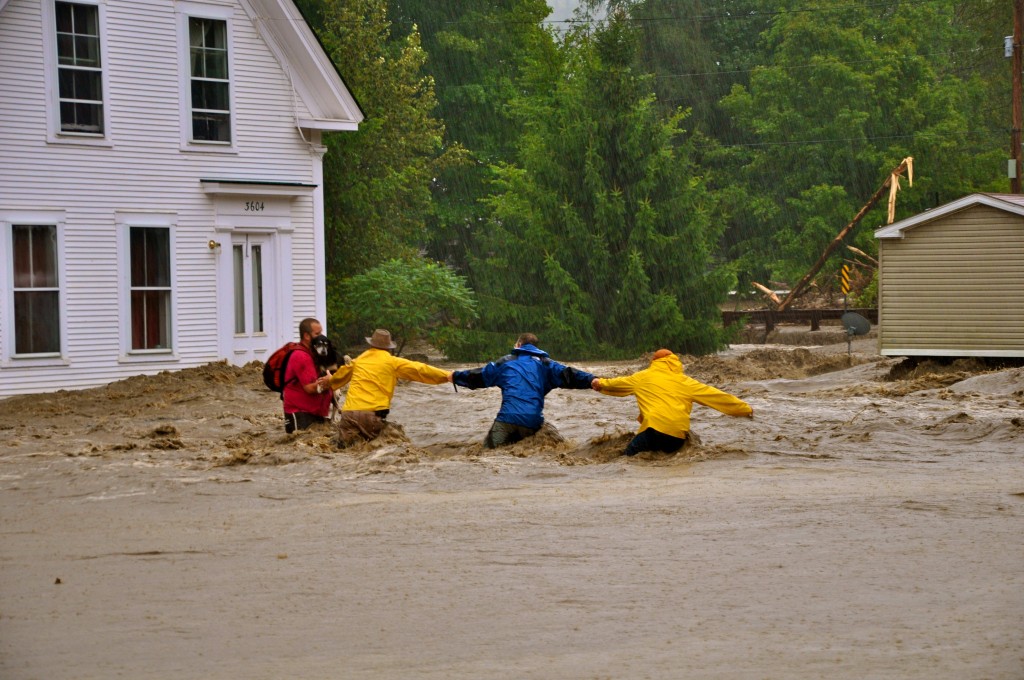By Fran Putnam

Future storms similar to Irene are inevitable. We must take bold steps, like the carbon pollution tax, to help to slow climate change. This photo was taken in Pittsfield, Vt., during Hurricane Irene. Photo: Barb Wood
The recent launch of an effort to put a price on carbon pollution in Vermont is a forward-looking, smart economic strategy. A growing, diverse coalition of businesses, low-income organizations, environmental groups and citizens have looked hard at the benefits, costs and potential policy framework for taking this step.
The coalition commissioned an economic analysis to understand the impacts of a carbon pollution tax; an analysis recently undertaken by the independent Regional Economic Models (REMI), a firm often hired by the State of Vermont. The results of the study show that a well-crafted policy can reduce Vermont’s fossil fuel use, add jobs and stimulate our economy in a way that is equitable for all Vermonters.
On the surface, it might seem odd to believe that an assessment on carbon pollution could stimulate our economy. Understanding how this tax would work is crucial to understanding how that can be true.
Currently, most of the money Vermonters spend on fossil fuels goes out of state to large corporations, doing little for our economy. The report highlights that in 2012 Vermonters bought over $1.2 billion worth of gasoline with only about 25% of this value remaining in the state through retail sales and distribution.
That equates to a loss of $900 million to imports from other states, countries, and continents (nearly 3% of gross state product). The independent REMI analysis states, “Reducing these imports could ‘keep more dollars local,’ grow the Vermont economy, and create more jobs.”
One of the reasons pricing carbon pollution in Vermont would work well is that all of the proceeds from it would stay in Vermont.
As currently conceptualized, a full 90% of the revenue would be returned to Vermonters in the form of rebates and tax relief; half to individuals and half to businesses, governmental agencies and non-profits.
The remaining 10% would be dedicated to helping Vermonters and Vermont businesses make investments in clean energy solutions, such as weatherization improvements, renewable energy, efficiency of transportation, etc.
Special attention would be given to lower income Vermonters to address the fact that they spend a higher percentage of their income on gasoline and fuel oil compared to other Vermonters. The proposal currently envisions twice as many dollars going back to lower income Vermonters, potentially partially as a rebate and partially as more immediate dollars.
Importantly, this plan would be phased in over a 10-year period, giving people the opportunity to adjust and make the energy-saving investments that will, ultimately, save them far more over time. The maximum cost of one scenario would have the pollution price rise to 45¢ in the tenth year; that’s far less money than we expended recently, when the cost of gasoline was near the $4 pergallon mark.
Should Vermont be the first state to put a price on carbon pollution? If we believe that economic stimulation is good for our state, and we want to help Vermonters make the homes, businesses, and vehicles more energy efficient, I say yes. This is a plan to take seriously.
It’s also important to note that this is not a new approach. Places like British Columbia have had such a policy in place since 2008, and they are meeting their objectives. It is also a policy that a growing number of high profile conservative economic experts are promoting. For instance, Henry Paulson, treasury secretary under George W. Bush, supports it. Republican strategist George Shultz, who served as Ronald Reagan’s Secretary of State and Richard Nixon’s Secretary of Labor, also supports such a tax.

Soot put into the atmosphere by fossil fuels can be seen from space. NASA photo
The REMI study and the carbon-pricing proposal is a good starting point for a far-reaching discussion. I hope those debating its merits will look at the details, including the REMI study, which can be found by clicking on the REMI logo at the following website www.energyindependentvt.org/
This is a bold approach, but we cannot afford to wait. As leading scientists and entities like the Pentagon and the World Bank have noted, unless urgent action is taken very soon, it will become extremely costly to reduce emissions fast enough.
So we must let facts – not fear – drive this important conversation. Vermont is already experiencing major climate changes, and we have experienced the costly wrath of storms like Irene. Future storms are likely to be worse without substantive action.
Business as usual is not working. It’s time to tackle this problem at the policy level, and a serious discussion about putting a price on carbon should be part of the mix.
Weybridge, VT resident Fran Putnam is active at the local level on efficiency, renewable energy and climate solutions.








Leave a Reply